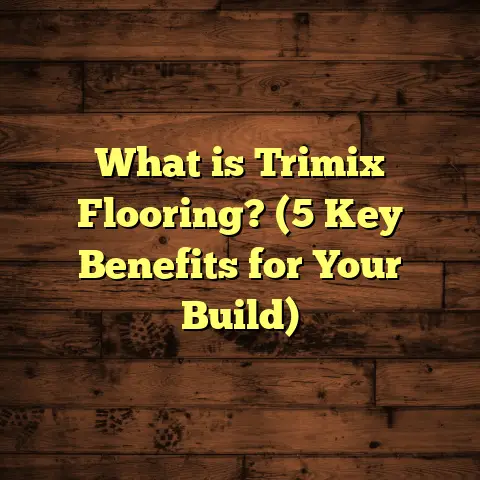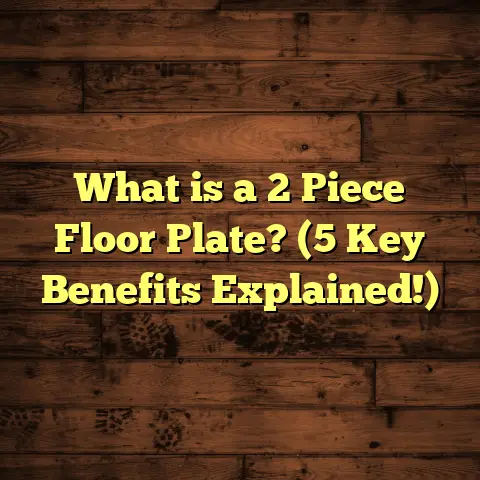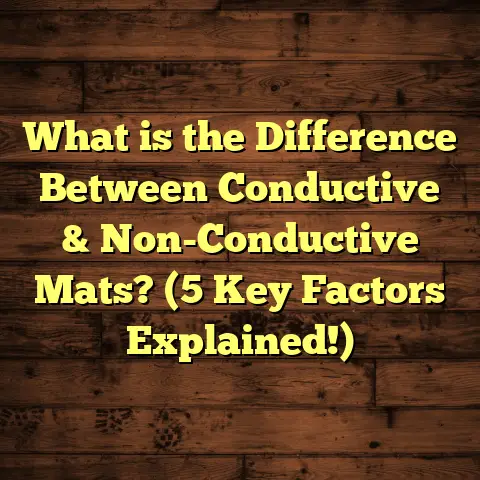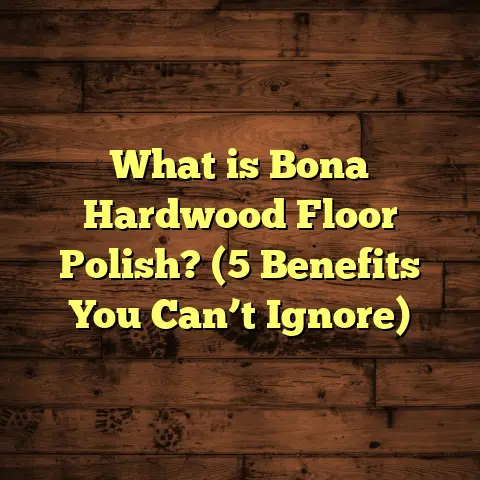What is Vinyl Plank Flooring? (5 Benefits You Must Know!)
Below is the expanded version with rich, detailed content organized in structured sections. The writing style remains conversational and engaging, as requested.
I still remember the first time I saw vinyl plank flooring installed in a home. It was a modest living room, but the floor looked as warm and natural as hardwood. I was curious — what exactly is vinyl plank flooring? How does it manage to look so good while being so affordable and practical? Since then, I’ve worked with vinyl plank floors on dozens of projects, and I’m confident it’s become one of the most versatile flooring options out there. Let me tell you everything I’ve learned about vinyl plank flooring and why it’s worth considering if you’re thinking about updating your floors.
What is Vinyl Plank Flooring?
Vinyl plank flooring is a type of resilient flooring designed to imitate the look of natural wood planks. Unlike traditional hardwood, vinyl plank flooring is made from synthetic materials, primarily polyvinyl chloride (PVC), which gives it durability and water resistance.
These planks come in standard sizes ranging from 6 to 9 inches wide and 36 to 48 inches long. Thickness varies from about 4 mm to 8 mm depending on the product line and quality. The core layer can be flexible or rigid — rigid core vinyl planks have become popular for their added stability, better feel underfoot, and ability to be installed over uneven subfloors.
Here’s how a vinyl plank is built:
- Wear Layer: A clear protective surface that shields against scratches, stains, and dents. Thickness here varies from 6 mil (0.15 mm) on budget products to 30 mil (0.75 mm) on commercial-grade flooring.
- Design Layer: A high-resolution photographic film that replicates wood grain or stone textures.
- Core Layer: The backbone providing structure, which can be SPC (stone plastic composite), WPC (wood plastic composite), or flexible vinyl.
- Backing Layer: Adds support and moisture barrier properties.
The top wear layer is crucial because it determines the floor’s durability. For example, in homes with children or pets, a thicker wear layer ensures the floor lasts longer without scratching or staining.
Vinyl planks can be installed as floating floors using click-lock mechanisms or glued down for permanent placement. Installation times vary but generally are faster than hardwood or tile — a 500-square-foot room can often be completed within a day by experienced installers.
How Vinyl Plank Flooring Works in Different Environments
One of the reasons vinyl plank flooring has grown so popular is its adaptability. You’ll find it in kitchens, bathrooms, basements — even commercial spaces like retail stores and offices.
Its waterproof nature means it thrives where moisture is an issue. Unlike hardwood, which warps or swells from water damage, vinyl holds up well in damp or humid environments. This has made it a favorite for basements and areas prone to spills.
Five Benefits You Must Know About Vinyl Plank Flooring
1. Durability That Handles Everyday Living
I’ve seen floors endure a lot — kids running around, pets scratching at doors, furniture being dragged across the surface. Vinyl plank flooring stands up to all this with surprising toughness.
The wear layer thickness is a key factor here. For residential settings, I recommend at least a 12-mil wear layer; for commercial or heavy traffic homes, 20-30 mil wear layers are ideal.
In one of my recent installations for a family with two dogs and three kids, we went with a commercial-grade vinyl plank with a 25-mil wear layer. After two years of heavy use, the floor showed barely any scratches or signs of wear.
This durability also translates into fewer repairs or replacements over time — which saves you money in the long run.
2. Water Resistance That Makes Life Easier
Ever spilled red wine on your hardwood floor? Or had your washing machine leak? These are moments where vinyl plank flooring shines.
It’s either waterproof or highly water-resistant due to its PVC composition and tight locking systems. Some products even boast full submersion waterproofing.
I installed vinyl plank flooring in a basement laundry room that had flooding issues in the past. The homeowners told me they could mop freely without worrying about water damage or buckling.
Maintenance becomes straightforward — just sweep or damp mop regularly without special cleaners or sealants needed.
3. Affordability That Doesn’t Skimp on Style
Budget is often the main concern when choosing flooring. Vinyl plank flooring hits a sweet spot by providing wood-like appearance without the price tag of hardwood.
Material costs range between $2 and $5 per square foot depending on quality and brand. Labor typically adds another $1.50 to $3 per square foot for installation.
Compared to hardwood floors costing between $8 and $15 per square foot installed, that’s a significant saving.
I once helped a young couple replace their aging carpet in a 1,200-square-foot condo with vinyl plank flooring at around $3 per square foot installed. They loved that they got the wood look they wanted while staying within their tight budget.
4. Quick and Easy Installation
One major advantage I appreciate as a contractor is how fast vinyl plank floors go down.
Most products use click-lock edges that snap together over an underlayment for floating installations. This eliminates glue drying times or nailing hassles.
For smaller rooms up to 500 square feet, an experienced installer can finish within a day.
I often use FloorTally before starting jobs to calculate exact material needs and labor costs based on local rates — this helps me plan the timeline accurately and avoid ordering too much material or wasting time.
For larger spaces like open-plan kitchens plus living rooms covering 1,500 square feet, installation might take two to three days including prep work like removing old floors or leveling subfloors.
5. Style Variety That Fits Any Space
One thing that impressed me over time is how manufacturers have upped their game on aesthetics.
You can find everything from rustic barn wood looks to sleek urban oak finishes. Textured surfaces simulate saw marks or hand-scraped details for authenticity.
Some newer lines even offer embossed-in-register technology — meaning the texture lines up perfectly with the printed wood grain pattern for an ultra-realistic feel.
This variety lets you tailor your floors to your home’s personality without compromise.
How I Approach Vinyl Plank Flooring Projects: Personal Stories and Insights
A few years back, I helped renovate a kitchen/dining area for a family who wanted durable floors but didn’t want traditional hardwood due to moisture near their sink area.
We chose rigid core vinyl planks with a 20-mil wear layer for durability and water resistance.
The installation took two days at around $4 per square foot including labor.
Six months later, the family told me they loved how easy spills were to clean up and how the floor still looked brand new despite active kids running around all day.
That project cemented my belief that vinyl plank flooring is perfect for busy households needing style plus practicality.
Vinyl Plank Flooring Breakdown: Materials, Cost & Installation Details
Understanding Thickness and Wear Layers
Thickness ranges from 4 mm to 8 mm:
- 4 mm: Budget or DIY-grade options
- 5-6 mm: Mid-range for residential use
- 7-8 mm: Premium commercial-grade with rigid cores
Wear layers usually range:
- 6 mil (0.15 mm): Light residential use
- 12 mil (0.3 mm): Standard residential
- 20-30 mil (0.5 – 0.75 mm): Commercial/high-traffic areas
Cost Estimates Based On Real Data
| Item | Cost per Sq Ft | Notes |
|---|---|---|
| Vinyl Plank Material | $2 – $5 | Depends on thickness & brand |
| Labor | $1.50 – $3 | Floating installation preferred |
| Underlayment | $0.25 – $0.75 | Optional but recommended |
| Removal of Old Flooring | $1 – $2 | If required |
Example: A 600-square-foot kitchen/dining area might cost:
- Materials: 600 × $3 = $1,800
- Labor: 600 × $2 = $1,200
- Underlayment: 600 × $0.50 = $300
- Total ≈ $3,300
Installation Timeframe
- Small rooms (under 500 sq ft): 1 day
- Medium rooms (500–1,000 sq ft): 1–2 days
- Large projects (>1,000 sq ft): 2–4 days depending on prep work
Tools I Use: FloorTally
Before every job, I use FloorTally to input room dimensions,
material choices,
and local rates,
which generates accurate cost estimates including waste factors.
This helps me avoid ordering excess material or underestimating labor hours,
which keeps my projects running smoothly.
Comparing Vinyl Plank Flooring With Other Popular Floors
Here’s how vinyl plank stacks up against other common options:
| Flooring Type | Durability | Water Resistance | Cost/Sq Ft Installed | Maintenance |
|---|---|---|---|---|
| Hardwood | High | Low | $8 – $15 | Periodic refinishing |
| Laminate | Moderate | Low | $3 – $7 | Sensitive to moisture |
| Vinyl Plank | Very High | Very High | $3 – $6 | Easy cleaning |
| Ceramic Tile | Very High | Very High | $5 – $10 | Grout upkeep needed |
If you want the wood look combined with water resistance and easy care,
vinyl plank often wins out over laminate or hardwood in busy homes or damp areas.
Installation Tips from My Experience
When installing vinyl plank flooring,
preparation is key:
- Make sure subfloor is clean,
dry,
and level (within 3/16 inch over 10 feet).
- Acclimate planks in your home for at least 48 hours before installation.
- Use underlayment if recommended by manufacturer for soundproofing and comfort.
- Leave expansion gaps along walls (usually ¼ inch).
- Start installation along the longest straight wall.
- Stagger end joints by at least 6 inches for natural look.
- Cut planks with a utility knife or saw designed for vinyl.
- Check locking mechanisms carefully; avoid forcing planks together too hard.
- After installation, place furniture gently at first to avoid denting.
Maintenance Tips That Keep Floors Looking New
Vinyl plank floors are low maintenance but here are some tips I swear by:
- Sweep or vacuum regularly to remove grit.
- Use damp mop with mild cleaner designed for vinyl.
- Avoid abrasive scrubbers or harsh chemicals.
- Use felt pads under furniture legs.
- Clean spills immediately to prevent staining.
- Avoid prolonged exposure to direct sunlight to minimize fading.
Real Case Study: Vinyl Plank Flooring in a Family Home
A client approached me about replacing their outdated tile kitchen floor with something warmer and easier on bare feet.
They had two young kids and wanted something durable yet stylish under $5 per square foot installed.
After reviewing options,
we chose rigid core vinyl planks with a textured oak finish and 20-mil wear layer.
Installation took two days including removal of old tile and leveling subfloor.
Three years later,
the homeowners report zero issues:
no stains,
no scratches,
and easy cleanup after spills or muddy shoes.
They appreciated the quick installation process too because their kitchen downtime was minimal.
Environmental Impact & Sustainability
Vinyl flooring is often criticized for environmental reasons because of PVC content and manufacturing emissions.
However,
many manufacturers have started producing eco-friendlier products by:
- Using recycled materials in cores.
- Reducing VOC emissions.
- Offering recycling programs.
It’s worth asking your supplier about certifications like FloorScore or GreenGuard if sustainability matters to you.
FAQs About Vinyl Plank Flooring
Q: Can vinyl planks be installed over existing floors?
A: Yes, provided the existing floor is smooth, clean, and stable (like concrete or wood). Avoid installing over carpet.
Q: How long does vinyl plank flooring last?
A: With proper care and quality wear layers, expect 10–20 years of use, sometimes longer in residential settings.
Q: Is vinyl plank flooring noisy?
A: It can be if installed directly on concrete without underlayment. Using proper underlayment reduces noise significantly.
Q: Can I install vinyl plank flooring myself?
A: Yes! Many products are designed for DIY installation with click-lock systems. Just follow manufacturer instructions carefully.
Final Thoughts on Vinyl Plank Flooring
Vinyl plank flooring combines style,
durability,
affordability,
and ease of care in ways few other floors can match.
If you want something that looks like wood but works better in busy households or moist areas,
this might be exactly what you need.
I hope my experiences and insights help you make an informed choice!
Feel free to reach out if you want personalized advice based on your space and needs — I’m here to help!





